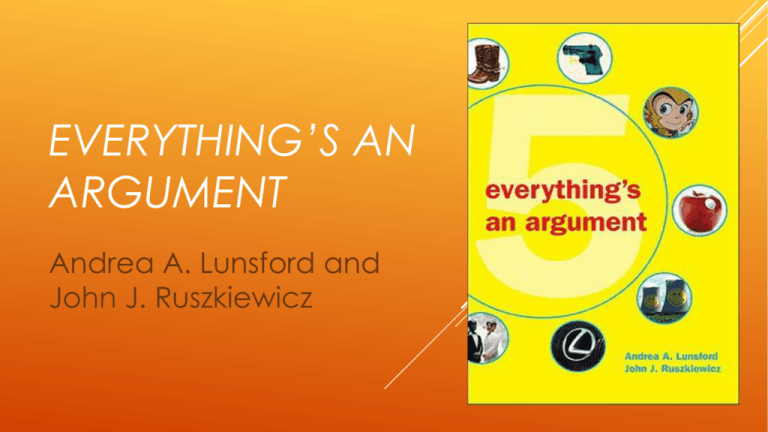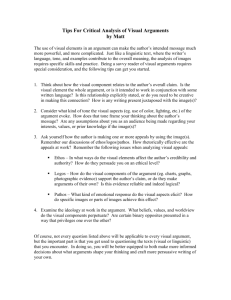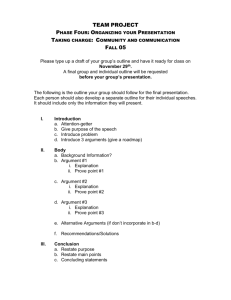Everything*s An Argument
advertisement

EVERYTHING’S AN ARGUMENT Andrea A. Lunsford and John J. Ruszkiewicz In general, what is an argument? A claim or particular point of view. How can the clothes you wear, the foods you eat, and the groups you join act as an argument? It demonstrates who you are and what you value. An argument can be any text – written, spoken, or visual – that expresses a point of view. Sometimes arguments can be blunt and aggressive; sometimes arguments can be subtle or hidden. WHAT IS AN ARGUMENT? HOW IS THIS AN ARGUMENT? HOW IS THIS AN ARGUMENT? HOW IS THIS AN ARGUMENT? HOW IS THIS AN ARGUMENT? AUTHOR AND PURPOSE Argument is to use evidence and reason to discover some version of the truth or conviction. Persuasion is to change a point of view or to move others from conviction to action. Persuasion that is designed to change opinions at all costs – abandoning reason, fairness, and truth – is propaganda, or to some advertising. ARGUMENT VERSUS PERSUASION Not all language uses aims to win over others (in contrast to the traditional Western concept of argument being a disputation or combat). Ex. Fast Food Nation Reasons for an argument: -Inform (street signs, reviews, newspaper headlines) -Convince (reports, articles) -Persuade (Ads, political blogs, An argument can also be an newspaper editorials) invitation that aims not to defeat another person or group but to -Explore (Expository essays, such as invite others to enter a space of “Once More to the Lake”) mutual regard and exploration. Ex. -Make Decisions (Essays, articles) Outliers -Mediate or pray (Sermons) -Academic (Essays, reports) PURPOSES OF ARGUMENT Arguments about the past. Forensic arguments are debates about what happened in the past; common in business, government, and academia. Relies on evidence and testimony; also, precedents – actions or decisions made in the past that influence policies or decisions in the present. Arguments about the future. Deliberative arguments debate what will or should happen in the future. Relies on prior forensic arguments, as well as projections, extrapolations, and reasoned guesses. Arguments about the present. Ceremonial arguments are often about contemporary values, such as addresses, speeches, sermons, eulogies, and other civic speeches. Praises what’s admirable and blames what’s not. OCCASIONS FOR ARGUMENTS Stasis Theory is categorizing arguments based on the issues they address. Arguments of Fact: involves a statement that can be proved or disproved with specific evidence or testimony. Ex. Global warming. Arguments of Definition: involves questions of definition – what something is or isn’t. Ex. Is a human fetus a human being? Arguments of Evaluation and Causality: measuring individual people, ideas, or things against another; what caused a circumstance or situation? Ex. Is a hybrid car better than a regular car? What are the causes of climate change? Arguments of Proposal: identifies a problem and proposes a course of action that will lead to a solution. Stasis in Action: Choose a topic, and use one of the types of arguments above to write a 3-5 sentence argument. KINDS OF ARGUMENTS AUDIENCE An intended audience is the audience the writer or speaker consciously wants to address. Ex. During a graduation speech given by a valedictorian, whom might be the intended audience? Writer’s intentionally use certain diction, syntax, figurative language and imagery to reach his or her intended audience. (i.e. Rhetorical Analysis). “The most powerful resource any of us can have as we study and teach in university settings is full understanding and appreciation of the richness, beauty, and primacy of our familial and community backgrounds.” – Bell Hooks, “Keeping Close to Home: Class and Education” Whom is the intended audience? INTENDED AUDIENCE Rhetoric is the art of formal written and oral expression. “The art of thinking you thoughts and expressing them clearly.” Many philosophers (and a lot of teachers) believe that if you can’t express your thoughts clearly and logically, you are not thinking clearly. Also, thought of as the art of effective or persuasive speech, especially though the use of figures of speech, devices, and techniques. WHAT IS RHETORIC? Aristotle identified three key ways writers can appeal to his or her audiences: Ethos, Pathos, and Logos. Ethos is the presentation of self – whether the speaker or writer is trustworthy and/or credible. Pathos is to generate emotions (anger, fear, jealousy, empathy, pity, love) in readers. Logos is the use of reasons and evidence – facts, statistics, testimony, examples, narrative, or experience. APPEALING TO AUDIENCES In any argument, there is a relationship/dynamic between the speaker/writer (ethos), the audience (pathos), and the message (logos). Interpretation or effectiveness of the argument (purpose) depends on the context (situation) of the argument. RHETORICAL TRIANGLE A rhetorical analysis is a close reading of a text to analyze the effectiveness of an argument, as well as the components of an argument. Because arguments have many aspects, focus on elements that stand out. RHETORICAL ANALYSIS What is the author’s purpose? Who is the intended audience? Who is the writer or speaker? What claims are made? What evidence is used? What appeals or techniques – ethos, pathos, logos – are used and how? How does the language or style of the argument attempt to move or persuade an audience? (Diction, Syntax, Tone, Figurative Language, Imagery, etc.) Your rhetorical analysis itself will become an argument. However, whether you agree or disagree with the argument you are analyzing doesn’t matter. WHAT TO LOOK FOR







